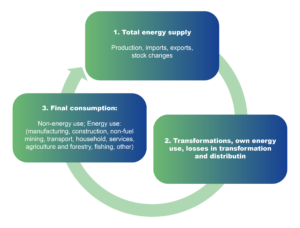Useful links
EUROSTAT is the statistical office of the European Union, responsible for publishing high-quality Europe-wide statistics and indicators that enable comparisons between countries and regions. The specific Energy section includes information and comprehensive databases about energy sector. https://ec.europa.eu/eurostat/web/energy/overview
United Nations Statistical Department (UNSD)’s mission in energy statistics area aims to strengthen national statistical systems to provide high quality energy statistics and balances. The UNSD collects annual and monthly energy statistics and disseminates them in the form of the publications: Statistical Yearbook, Energy Balances, Electricity Profiles and the Energy Statistics Pocketbook. https://unstats.un.org/unsd/energystats
International Energy Agency (IEA) is focused on the production timely, reliable, and accurate energy statistics with aim to ensure secure, affordable and sustainable energy system. Besides energy balances, the IEA publishes energy end-use and efficiency indicators, monthly statistics, oil stock, hydrogen production data and other. The main aim and purposes of this comprehensive energy statistics is to support forecasts and estimates for short-term, mid-term and long-term planning periods, energy policies development, development of new technologies and innovations and many others. (https://www.iea.org/data-and-statistics)
International Atomic Energy Agency (IAEA) promotes and prepares and develops energy statistics which is suitable for the feeding various energy planning tools (MAED, MESSSAGE, ESST, and other). IAEA develops own tool Energy Balance Studio (EBS) which aims to facilitate collection and organisation of energy data and to produce energy balance. (https://www.iaea.org/newscenter/news/experts-review-iaeas-analytical-tools-for-sustainable-energy-development)
EU ODYSSEE-MURE DATABASE is very specific database which encompass is developed to ensure comprehensive monitoring of energy efficiency trends and policy evaluation in EU Countries, Switzerland, and Energy Community countries. Database on energy efficiency indicators and energy consumption by end-use and related drivers covers industry, transport, households, and service sectors. (https://www.odyssee-mure.eu)

